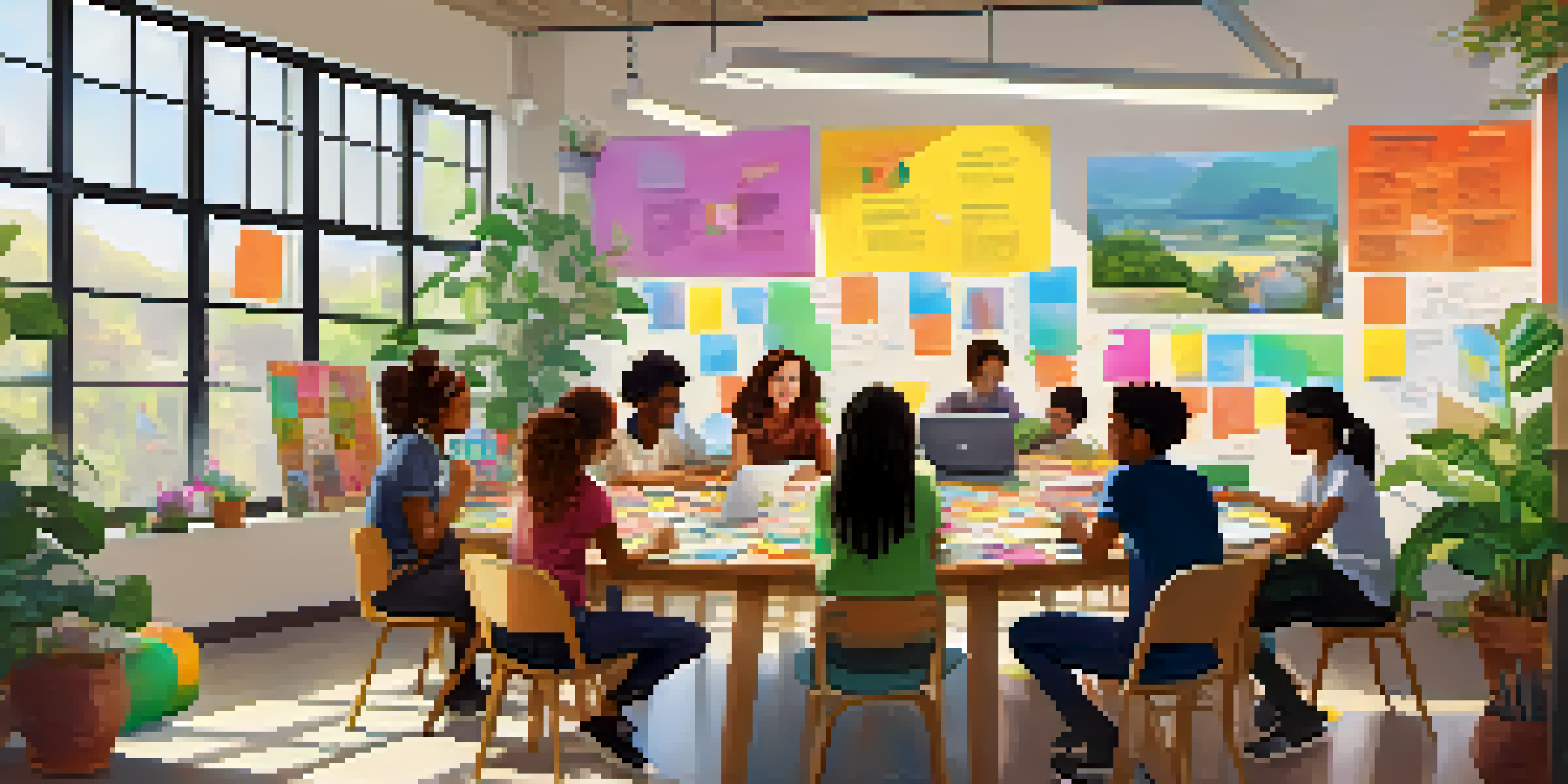Fostering a Growth Mindset in Diverse Learning Environments

Understanding Growth Mindset and Its Importance
A growth mindset is the belief that abilities and intelligence can be developed through dedication and hard work. This concept, popularized by psychologist Carol Dweck, emphasizes resilience and a love for learning. In diverse learning environments, fostering this mindset can lead to improved student engagement and achievement.
In a growth mindset, challenges are seen as opportunities to learn and grow.
When students embrace a growth mindset, they view challenges as opportunities rather than obstacles. This shift in perspective can be particularly beneficial in diverse classrooms, where students may face varying levels of support and resources. By promoting a growth mindset, educators can help students navigate their unique learning paths more effectively.
Moreover, a growth mindset encourages collaboration among students from different backgrounds. When learners recognize that everyone is on their own journey, they become more open to sharing ideas and learning from one another. This collaborative spirit not only enriches the educational experience but also builds a sense of community.
Creating an Inclusive Learning Environment
An inclusive learning environment is one where all students feel valued and empowered to participate. To foster a growth mindset, educators should prioritize inclusivity by recognizing and celebrating diverse perspectives, experiences, and strengths. This can be achieved through culturally responsive teaching practices that resonate with all students.

For instance, incorporating diverse literature and examples in lessons allows students to see themselves reflected in the curriculum. This representation helps students feel more connected and motivated to engage with the material. Additionally, encouraging students to share their unique experiences can enrich classroom discussions and promote empathy.
Embrace Challenges for Growth
A growth mindset encourages students to view challenges as opportunities for learning and development.
It's essential for teachers to create a safe space where students can express themselves without fear of judgment. By establishing ground rules for respectful communication and encouraging risk-taking in learning, educators can help students develop confidence in their abilities. This supportive atmosphere is key to nurturing a growth mindset among all learners.
Implementing Praise and Feedback Effectively
Effective praise and feedback play a crucial role in fostering a growth mindset. Instead of praising intelligence or talent, teachers should focus on effort, perseverance, and improvement. This approach helps students understand that their abilities can grow through hard work and practice.
The only limit to our realization of tomorrow will be our doubts of today.
For example, instead of saying, 'You're so smart,' a teacher might say, 'I really admire how hard you worked on that project.' This subtle shift in language encourages students to value effort over innate ability. It also reinforces the idea that mistakes are part of the learning process, rather than indicators of failure.
Additionally, constructive feedback should be specific and actionable. Instead of vague comments like 'Good job,' teachers can provide detailed insights on what students did well and areas for improvement. This targeted feedback not only guides students on their learning journey but also reinforces their belief in their capacity to grow.
Encouraging Resilience Through Challenges
Resilience is a key component of a growth mindset, and educators can play a vital role in helping students build this trait. When faced with challenges, students should be encouraged to view setbacks as learning opportunities. This perspective shift can be facilitated through discussions about famous figures who faced obstacles but persevered.
For instance, sharing stories of athletes or inventors who overcame failures can inspire students to adopt a similar mindset. Teachers can also create classroom activities that involve problem-solving and critical thinking, allowing students to practice resilience in a supportive environment. Encouraging a culture of 'failing forward' helps normalize setbacks as part of the learning journey.
Foster Inclusivity in Learning
Creating an inclusive environment celebrates diverse perspectives and empowers all students to participate actively.
Moreover, providing students with tools to cope with stress and frustration is essential for building resilience. Techniques such as mindfulness, goal-setting, and reflection can empower students to manage challenges more effectively. When students learn to bounce back from difficulties, they develop a stronger belief in their ability to grow and succeed.
Promoting Collaborative Learning Experiences
Collaboration among students is a powerful way to foster a growth mindset. Group work encourages learners to share their strengths and weaknesses, leading to a richer educational experience. In diverse classrooms, this collaboration can bridge gaps between students from different backgrounds and learning styles.
In practice, teachers can design activities that require teamwork, such as projects or problem-solving tasks. By assigning roles based on individual strengths, students can learn from one another and appreciate diverse perspectives. This collaborative approach not only enhances learning but also builds interpersonal skills essential for future success.
Furthermore, promoting peer feedback within groups can reinforce a growth mindset. When students give and receive constructive feedback from their peers, they develop a deeper understanding of the material and learn to view criticism as a tool for improvement. This practice helps cultivate an environment where students support each other's growth.
Integrating Technology for Personalized Learning
In today's educational landscape, technology can be a powerful ally in fostering a growth mindset. Digital tools and platforms allow for personalized learning experiences that cater to individual student needs. By leveraging technology, educators can create a more engaging and adaptable learning environment.
For example, adaptive learning software can assess a student's strengths and weaknesses, providing tailored resources to help them improve. This personalized approach not only enhances learning outcomes but also empowers students to take ownership of their educational journey. When learners see that they can progress at their own pace, their belief in their ability to grow strengthens.
Promote Collaboration Among Peers
Collaborative learning experiences enhance understanding and allow students to learn from each other's strengths.
Moreover, technology facilitates collaboration and communication among students, both in and out of the classroom. Online discussion forums and collaborative tools enable learners to share ideas and support one another, regardless of their location. This connectivity helps foster a sense of community and encourages a growth mindset among diverse learners.
Building a Growth Mindset Culture in Schools
Creating a culture that embraces a growth mindset requires commitment from both educators and administrators. Schools should prioritize professional development focused on growth mindset principles for teachers, equipping them with the tools to foster this mindset in their classrooms. This shared vision can have a profound impact on the entire school community.
Additionally, involving parents and guardians in this cultural shift is essential. Schools can offer workshops or resources that educate families about the benefits of a growth mindset, encouraging them to reinforce these principles at home. When parents and educators work together, students receive consistent messaging about the value of effort and resilience.

Finally, celebrating growth and progress, rather than just achievement, can help solidify this culture. Schools can recognize students who demonstrate perseverance and a willingness to learn from mistakes, fostering an environment where everyone feels empowered to grow. This culture of continuous improvement ultimately benefits all students in diverse learning environments.